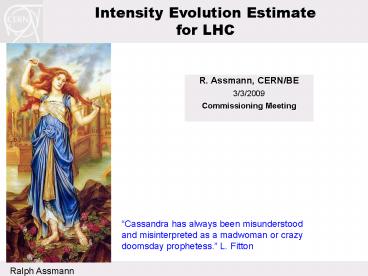Intensity Evolution Estimate for LHC - PowerPoint PPT Presentation
Title:
Intensity Evolution Estimate for LHC
Description:
Impossible to predict the ... However, baseline assumptions have been agreed for the design of the LHC, taking ... We cannot rely on hand waving arguments! ... – PowerPoint PPT presentation
Number of Views:43
Avg rating:3.0/5.0
Title: Intensity Evolution Estimate for LHC
1
Intensity Evolution Estimate for LHC
- R. Assmann, CERN/BE
- 3/3/2009
- Commissioning Meeting
Cassandra has always been misunderstood and
misinterpreted as a madwoman or crazy doomsday
prophetess. L. Fitton
2
LHC Proton Intensity Limit
- Impossible to predict the future precisely.
Especially as LHC enters into new territory with
intensities above 0.5 of its nominal design
value. - However, baseline assumptions have been agreed
for the design of the LHC, taking into account
experience with previous projects (ISR, SppS,
Tevatron, HERA, ). All checked and supported by
external experts. - Simulations predict performance limitation from
beam losses, based on clear physics process
(single-diffractive scattering) and limitation
in off-momentum phase space coverage in LHC
collimation. - Here, take baseline assumptions and assume
simulations results are correct. Add some
evolution to these values. Calculate performance. - Concentrate on collimation efficiency (assume
impedance less severe). Values for 7 TeV, lower
energy requires more work. Assume announced
quench limit! - All is ongoing work
3
Result Achievement Factor Beyond World Record in
Stored Energy
Looks very ambitious, doesnt it?
better
worse
4
Recent Reference
Chiara will present PhD in BE seminar on March
12th, 14h15. PhD report available for download
from web site LHC collimation project http//www.
cern.ch/lhc-collimation-project/PhD/bracco-phd-the
sis-2009.pdf
5
Error Magnet Alignment Errors
PhD C. Bracco
6
Impact of Imperfections on Inefficiency (Leakage
Rate)
worse
better
PhD C. Bracco
7
Impact of Alignment Errors on Inefficiency
(Leakage Rate)
worse
Year 1
Year 2
Year 3
better
Predicted inefficiency over 20 different seeds of
magnet alignment errors.
PhD C. Bracco
8
Collimation Phase II Ideal Cleaning Inefficiency
versus Re(Tune Shift)
R. Assmann, T. Weiler, E. Metral
Ideal Performance
worse
Phase I
Phase II
better
9
Input Cleaning Efficiency
better
/m
Coll. Phase II
Coll. Phase I
worse
10
as Inefficiency (Leakage Rate)
worse
better
Coll. Phase I
Coll. Phase II
11
A Look at Tevatron Efficiency
D. Still
factor 2 improvement per year
12
Input Peak Loss Rate
worse
better
13
Remarks Beam Loss Rate
- The LHC beams will have most of the time gt 20h
beam lifetime! - Original assumption for stored LHC beams Min.
intensity lifetime 20 h (after 20 min about 1
of beam lost). - However, every accelerator experiences regular
reductions of beam lifetime due to various
reasons - Machine changes in operational cycle Snapback,
ramp, squeeze - Crossing of high-order resonances during
operational cycle. - Operator actions during empirical tuning (tune,
orbit, chromaticity, coupling, ) with some small
coupling of parts of beam to instabilities - A 1 second drop in beam lifetime is sufficient to
have a quench and to end the fill. Collimation
must protect against these loss spikes. - Collimator design assumption changed toMin.
intensity lifetime 0.2 h (after 10s about 1 of
beam lost). - Based on real world experience (SppS, HERA,
Tevatron, RHIC, ISR, ).
14
Input BLM Threshold
better
Typical HERA threshold?
worse
15
Putting it together Performance Model
- The various important input parameters have been
put together into a preliminary performance
model. - Due to the short notice for this talk, please
take results with some care. I will need to
check. Also, some assumptions are questionable
and possibly too optimistic (BLM threshold
immediately at design value). - However, should give some good idea about what we
are looking at and what are the main parameters
expected to limit the LHC performance. - Such an approach takes into account the agreed
assumptions, the technical results and the
simulations of achievable performance.
16
Result Intensity Evolution(preliminary)
Limit from Collimation
Maximum in LHC
Collimation limited
Beam-beam limited
17
Result Fraction of Nominal Intensity(preliminary
)
World Record Stored Energy
18
Result Fraction of Nominal Intensity(preliminary
)
Coll. Phase I
Coll. Phase II
19
Input Evolution of b
Present Triplets
Triplet Phase I
20
Input Evolution of Bunch Intensity
21
Result Instantaneous Luminosity(preliminary)
Not fully correct need to improve model!
22
From Peak to Integrated LuminosityLEP Example
Can look into a LEP model which can be applied to
LHC. Note LHC much more complex and sensitive
than LEP!
23
Conclusion
- Put together baseline assumptions, as defined
years ago and explicit supported by persons with
real-world collider experience (Tevatron, SppS,
RHIC, HERA, LEP, SLC, PEP-2, ISR). - Put together available performance simulations
around collimation and beam loss. Other high
intensity side effects assumed OK
(electro-magnetic noise, heating from image
currents, instabilities, ). - Used info as input parameters to model for
intensity reach of the LHC. - Introduced some evolution in input parameters,
based on my personal judgment and experience in
various colliders. Should be discussed. - Obtain performance estimates versus time based on
technical arguments. - Will not claim that this is the truth but this is
the best possible estimate! - We cannot rely on hand waving arguments!
Technical experts should support the assumptions
in any estimate that is established!
24
Best Possible Estimate (Preliminary)
Note, that considerable uncertainties can affect
these results. However, results are not in
coherent with simulation results!































